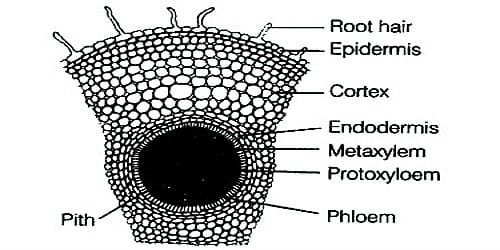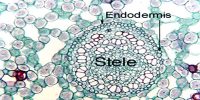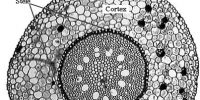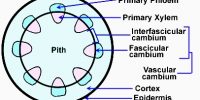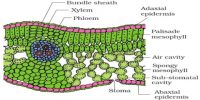Epiblema not completely produced epidermis which supplies or carry the area and region of the true epidermis in submerged plants and on the extremities of growing roots. It is the outermost layer of cells with a large number of unicellular root hairs. It is the outermost layer of cells that covers the whole plant. The epidermis is the outermost layer of cells that covers the whole plant. In the region of the root, this layer is called the epiblema. It is usually located between the epidermis and cortex in the root or stem of a plant.
(i) It is composed of one layer of compactly arranged parenchymatous cells
(ii) Unicellular root hairs are present in the epiblema.
Epiblema is the single outermost layer of the root. It is mostly colorless, shadeless, polygonal without any intercellular spaces and related issue, with the presence and occurrences of unicellular root hairs of plants, hence also called a piliferous layer or rhizodermis. It is made of efficiently arranged thin-walled compacted and slightly elongated parenchymatous cells. The cells are typically thin-walled since they are involved in the absorption of water. It is a part of the root which helps to stop water absorbed to flow out and to absorb liquids.
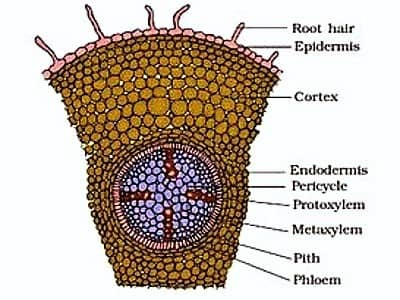
Function:
- To absorb water and mineral with the help at unit hairs.
- To protect the inner tissues.
- These help in the absorption of water.
- The root hairs and thin-walled shaped epidermal cells can take part in the absorption of water and minerals from the soil and environment. Some cells are produced into long unicellular projections called root hairs.
- It is made from spongy dead cells which help in the absorption of water from the atmosphere. It also checks excessive loss of water from the cortex.
- They take part in the absorption of water and mineral salts. In older parts, the epiblema is shed or becomes impermeable.
Some cells of the epiblema give rise to thin-walled tubular outgrowths called root hairs. They are called trichoblasts. Generally, cuticle and stomata are absent in most plants. It imperfectly produced epidermis which supplies the region of the true epidermis in submerged plants and on the extremities of growing roots of plants. A few of the epiblema cells are formed and produced into long unicellular projections called root hairs.
Formation
- Epiblema is the mostly outermost unilayered region with various unicellular root hairs. It consists of very thin-walled, mostly arranged living parenchymatous cells in plants.
- It is the outermost layer of cells.
- The cells usually have fine tubular elongations, called root hairs. It is uniseriate and composed of horizontally flattened, compactly arranged parenchyma cells.
- Cells are thinly walled. Some of these cells extend into unicellular root hairs.
- Usually, Epiblema has no stomata but bears unicellular epidermal root hairs and less amount of cutin. Sometimes the epiblema might be less cuticularised. It contains more cuticle than dicot roots.
- It generally provides protection or guard to the roots due to the presence or occurrences of unicellular root hairs in plants, it also aids in the absorption of water and minerals from the soil and environment.
- The epiphytes have several layered hygroscopic epidermises, called velamen tissues. Generally, epiblema is characterized by absence of stomata and cuticle.
- Usually, the wall of velamen has a spiral or reticulate secondary thickening of cellulose, pectin, and lignin.
